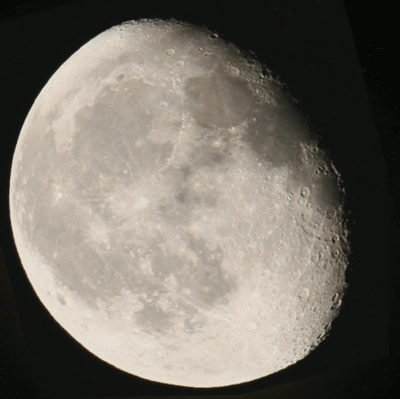 Back indeed, with the animated gif (pronounced, “GAL-eh-fray”) that I wanted to include, because it shows better this way. I tweaked the colors to come close to matching, and while it might seem that I didn’t line them up well enough, I think we’re actually seeing the libration between the two shooting sessions, the wobble that the moon performs as it orbits the Earth and revolves; it’s not perfectly locked to facing exactly the same way, and changes during the month. This might be a little excessive for just a day (actually, 2:02 AM to 11:07 PM,) so, yeah, alignment may be off a bit too.
Back indeed, with the animated gif (pronounced, “GAL-eh-fray”) that I wanted to include, because it shows better this way. I tweaked the colors to come close to matching, and while it might seem that I didn’t line them up well enough, I think we’re actually seeing the libration between the two shooting sessions, the wobble that the moon performs as it orbits the Earth and revolves; it’s not perfectly locked to facing exactly the same way, and changes during the month. This might be a little excessive for just a day (actually, 2:02 AM to 11:07 PM,) so, yeah, alignment may be off a bit too.
[A note: The moon follows the path of the ecliptic across the sky, with the illuminated portion facing the sun of course, while we face any damn way. I made the attempt to correct for the angle difference between the first and second sessions, but it wasn’t going to be perfect, so it took aligning the two moon photos in size and rotation to make a near-match – and this is not easy nor fun. I have to admit, Photoshop makes it easier than GIMP, but I was logged into Linux this time, so…]
I also did a little research, because that speck that crossed in front of the moon had me intrigued. And still does, because so far, I’ve found no matching satellite. Stellarium allowed me to roll back to the time period, but showed nothing – which may have been because the magnitude of the satellite fell outside of its parameters. I know I looked carefully after it passed, trying to see if I could make out any glowing/reflective points in the darkness along its path, but with the glare of the moon, it could easily have been missed – or simply too dim to see regardless, except for a very long exposure.
Meanwhile, Heavens Above didn’t tag anything either, though again, they seem to drop out any falling at less than 5 magnitude, and they don’t roll back in time very well. I checked their list of visible passes for anything, and nothing fell within that time period.
If it was a plane, it was very high, because it was a mere speck against the moon even at 600mm. If it was a bird – well, it almost certainly wasn’t a bird, because it was moving too fast for the altitude it likely would have been to be that small.
I’m kind of irked that I missed it, convinced that I would have had a photo had I been faster on the reflexes, but there’s also the naked fact that I was shooting with mirror lockup to reduce camera vibration, so I would have had to have triggered the shutter twice before it vanished, plus doing it that way would have negated the purpose of mirror lockup to begin with. So chances are I wouldn’t have caught anything no matter what, unless I already knew it was coming. Which, someday with the ISS, may happen. That’s very tricky, because the path on Earth where you can see the ISS in front of the moon is fairly narrow, and most sources don’t plot positions that precisely.
[Another note: both the mirror slapping out of the way, and the shutter slapping open, introduce vibration into the camera – minimal, but at high magnifications and especially at longer exposures, this can affect sharpness because the camera is moving during the exposure. Thus, mirror lockup is a custom function to move the mirror out of the way before tripping the shutter, preferably a few seconds before, so the vibrations have a chance to die down, and I usually use it on astrophotography, as I was for both sessions. As well as the remote release, so I wasn’t even handling the camera. The shutter vibrations really don’t have a solution, but at least for the moon, the exposure period is short enough that the impact is trivial – not so much for some other, dim subjects.]
Now I’ve gone and set a precedent for the month, and might have to see how many other moon photos I end up with. Rest assured though, I have some other subjects to mess with in the meantime.



















































